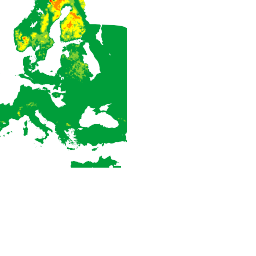什麼是通用花粉指數 (UPI)?
通用花粉指數 (UPI) 採用全球統一的標準,方便比較不同地區的花粉濃度。花粉指數會根據多項因素,評估對花粉過敏或敏感者接觸花粉的風險。這項資料是以多層模型為基礎,考量每種植物模型的濃度、全球使用的許多不同當地花粉指數 (LPI),以及不同植物花粉類型的致敏性,預測每日每立方公尺的花粉粒數 (粒/公尺 3)。
heatmapTiles 端點會傳回可疊加在基本地圖上的熱視圖圖塊。熱度圖圖塊會顯示特定植物類型 (TREE、GRASS 或 WEED) 的全球 UPI。
這項指數分為六個類別:
| 值 | 顏色 | 說明 |
|---|---|---|
| 0 | 無 | |
| 1 | 極低 | |
| 2 | 低 | |
| 3 | 中 | |
| 4 | 高 | |
| 5 | 非常高 |
每個類別都以特定區域的花粉濃度為依據,以及花粉對一般過敏症狀嚴重程度的影響,全面呈現花粉濃度。整合 UPI 後,使用者就能比較及評估不同地點的花粉狀況。
舉例來說,以下熱視圖方塊顯示的花粉濃度範圍從「非常低」到「非常高」:TREE

支援的植物
花粉 API 支援 3 種不同類型的植物:草、雜草和樹木。由於植物的供應情形取決於實際資料來源的測量結果和報告,花粉 API 的植物資料可能會因地點而異。
以下列出支援的植物代碼及其相關中繼資料:
| 工廠代碼 | 顯示名稱 | 類型 |
|---|---|---|
ALDER |
Alder | 樹 |
ASH |
清水模灰 | 樹 |
BIRCH |
樺木灰 | 樹 |
COTTONWOOD |
Cottonwood | 樹 |
ELM |
Elm | 樹 |
MAPLE |
Maple | 樹 |
OLIVE |
Olive | 樹 |
JUNIPER |
Juniper | 樹 |
OAK |
橡木 | 樹 |
PINE |
Pine | 樹 |
CYPRESS_PINE |
柏松 | 樹 |
HAZEL |
霧灰色 | 樹 |
GRAMINALES |
禾草 | 草 |
JAPANESE_CEDAR |
日本柳杉 | 樹 |
JAPANESE_CYPRESS |
日本扁柏 | 樹 |
RAGWEED |
豚草 | 雜草 |
MUGWORT |
艾草 | 雜草 |

